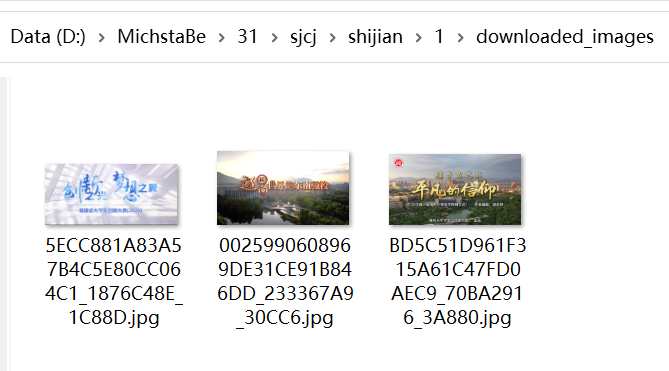数据采集与融合技术实践作业一
作业1:大学排名数据爬取
作业代码和图片
- 主要代码
import urllib.request from bs4 import BeautifulSoup import re # 导入正则表达式模块 # 指定要爬取的URL url = 'http://www.shanghairanking.cn/rankings/bcur/2020' # 发送请求获取网页内容 response = urllib.request.urlopen(url) html_content = response.read().decode('utf-8') # 使用BeautifulSoup解析网页内容 soup = BeautifulSoup(html_content, 'html.parser') # 找到存放排名信息的表格(假设表格在页面中唯一或具有特定的class属性) table = soup.find('table') # 提取表格中的所有行 rows = table.find_all('tr') # 打印表头 print(f"{'排名':<5}{'学校名称':<10}{'省市':<10}{'学校类型':<10}{'总分':<10}") # 遍历每一行,提取并打印所需信息 for row in rows[1:]: # 跳过表头行 cols = row.find_all('td') if len(cols) >= 5: # 确保每行至少有5列数据 rank = cols[0].get_text(strip=True) # 使用正则表达式只保留中文字符,去掉英文部分 university_name = re.findall(r'[\u4e00-\u9fa5]+', cols[1].get_text(strip=True))[0] province_city = cols[2].get_text(strip=True) university_type = cols[3].get_text(strip=True) total_score = cols[4].get_text(strip=True) # 格式化输出 print(f"{rank:<5}{university_name:<10}{province_city:<10}{university_type:<10}{total_score:<10}")
- 运行结果

作业心得
通过此次作业,我深入理解了如何使用requests库发送HTTP请求,并使用BeautifulSoup解析HTML文档。数据提取的过程让我体会到了网络爬虫的强大与灵活性。同时,我也认识到在爬取数据时要遵循网站的规则,以避免对网站造成负担。
作业2:商城爬虫
作业代码和图片
- 主要代码
import urllib.request from bs4 import BeautifulSoup import re BASE_URL = "http://search.dangdang.com/?key=%E4%B9%A6%E5%8C%85&act=input" def get_html(url): #获取指定url的HTML内容 head = { "User-Agent": "Mozilla/5.0 (Windows NT 10.0; Win64; x64) AppleWebKit/537.36 (KHTML, like Gecko) Chrome/109.0.0.0 Safari/537.36 SLBrowser/9.0.3.5211 SLBChan/123" } request = urllib.request.Request(url, headers=head) try: response = urllib.request.urlopen(request) return response.read().decode('gbk') except urllib.error.URLError as e: if hasattr(e, "code"): print(e.code) if hasattr(e, "reason"): print(e.reason) return None def get_data_from_html(html): #从HTML内容中提取商品名称和价格 soup = BeautifulSoup(html, "html.parser") names = [] prices = [] for items in soup.find_all('p', attrs={"class": "name", "name": "title"}): for name in items.find_all('a'): title = name['title'] names.append(title) for item in soup.find_all('span', attrs={"class": "price_n"}): price = item.string prices.append(price) return names, prices def print_goods_info(names, prices): #打印商品名称和价格信息 print("序号\t\t\t", "价格\t\t\t", "商品名\t\t") for i, (name, price) in enumerate(zip(names, prices)): # 去除多余的空白字符 name = re.sub(r'\s+', ' ', name) # 提取数字和小数点 price = re.findall(r'[\d.]+', price) if price: print(f"{i + 1}\t\t\t {price[0]}\t\t\t{name}") def main(): names = [] prices = [] for i in range(1, 3): # 爬取1-2页的内容 url = BASE_URL + "&page_index=" + str(i) html = get_html(url) if html: page_names, page_prices = get_data_from_html(html) names.extend(page_names) prices.extend(page_prices) print_goods_info(names, prices) if __name__ == "__main__": main()
- 运行结果

作业心得
在这次作业中,我学习了如何使用re库进行正则表达式匹配,从网页中提取特定的数据。同时,我也意识到需要根据具体网页结构进行调整,灵活性是编写爬虫的关键。
作业3:爬取网页JPEG和JPG格式文件
作业代码和图片
- 主要代码
import os import requests from bs4 import BeautifulSoup from urllib.parse import urljoin # 要爬取的URL url = 'https://news.fzu.edu.cn/yxfd.htm' # 发送请求获取网页内容 response = requests.get(url) html_content = response.content # 使用BeautifulSoup解析网页内容 soup = BeautifulSoup(html_content, 'html.parser') # 创建存储图片的文件夹 folder_name = 'downloaded_images' if not os.path.exists(folder_name): os.makedirs(folder_name) # 查找所有的图片链接(JPEG 和 JPG) img_tags = soup.find_all('img') # 遍历所有图片标签,下载JPEG和JPG格式的图片 for img in img_tags: img_url = img.get('src') # 确保img_url不为空 if img_url: # 将相对链接转换为绝对链接 img_url = urljoin(url, img_url) # 只下载JPEG和JPG格式的图片 if img_url.lower().endswith(('.jpg', '.jpeg')): # 获取图片的名称 img_name = os.path.basename(img_url) # 下载图片并保存到本地 img_data = requests.get(img_url).content img_path = os.path.join(folder_name, img_name) with open(img_path, 'wb') as handler: handler.write(img_data) print(f"已下载图片: {img_name}") print("所有图片下载完成!")
- 运行结果


作业心得
在这次作业中,我学会了使用Python爬取网页上的图片。通过BeautifulSoup解析网页,快速提取所有<img>标签的链接。使用urljoin将相对链接转换为绝对链接,确保下载的图片有效。




【推荐】国内首个AI IDE,深度理解中文开发场景,立即下载体验Trae
【推荐】编程新体验,更懂你的AI,立即体验豆包MarsCode编程助手
【推荐】抖音旗下AI助手豆包,你的智能百科全书,全免费不限次数
【推荐】轻量又高性能的 SSH 工具 IShell:AI 加持,快人一步